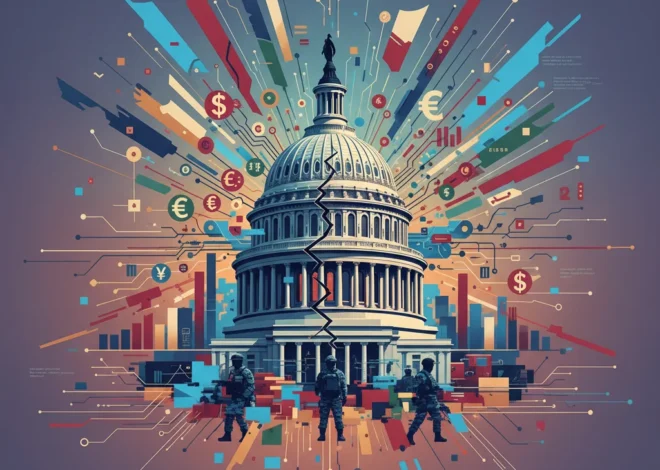
Beyond the Tinsel: Unpacking the Economic Signals Behind the Weakest Holiday Hiring Since 2008
The festive season typically brings with it a flurry of activity—not just for shoppers, but for job seekers as well. For decades, the holiday hiring surge has been a reliable economic pulse, a seasonal injection of employment and income that buoys local economies and signals corporate optimism. This year, however, that pulse is faint. For the first time in over a decade, many are finding the search for seasonal work unusually difficult, a sentiment echoed by stark economic data.
We are currently witnessing what is poised to be the most significant contraction in seasonal hiring since the depths of the 2008 financial crisis. According to a recent analysis, a potent combination of persistent tariffs and palpable consumer anxiety is prompting US businesses to adopt a stance of extreme caution (source). This isn’t merely a footnote in labor market statistics; it’s a critical leading indicator, offering a glimpse into the underlying health of the American economy and providing crucial signals for investors, finance professionals, and business leaders.
In this analysis, we will delve beyond the headline numbers to explore the multifaceted forces driving this trend. We will dissect the causes of corporate hesitancy, analyze the ripple effects across the broader economy and stock market, and draw parallels to historical economic shifts. Finally, we’ll examine how financial technology is reshaping the very nature of seasonal employment, creating a new paradigm for the years to come.
A Chilling Forecast: The State of Seasonal Employment
To fully grasp the magnitude of this shift, it’s essential to look at the numbers. The slowdown is not a minor dip but a significant deviation from recent trends, even when accounting for the volatility of the post-pandemic era. Businesses that would normally be onboarding thousands of temporary staff for warehouses, retail floors, and delivery routes are now scaling back dramatically.
This cautious approach is a direct reflection of their outlook on the crucial fourth-quarter sales period. The projected drop in hiring suggests that many corporations are bracing for a season of subdued consumer spending. Let’s place this year’s forecast into a broader historical context.
The following table illustrates the projected seasonal hiring figures for this year compared to key benchmarks, highlighting the severity of the decline:
| Year | Approx. Seasonal Jobs Added (U.S.) | Key Economic Context |
|---|---|---|
| 2023 (Projected) | ~400,000 | High inflation, rising interest rates, post-pandemic demand normalization. |
| 2022 | ~550,000 | Persistent inflation but resilient consumer spending from savings. |
| 2019 (Pre-Pandemic) | ~700,000 | Strong economy, low unemployment, stable growth. |
| 2008 | ~325,000 | Global Financial Crisis, widespread recession, banking system collapse. |
As the data shows, this year’s projected hiring is alarmingly close to the levels seen during the 2008 recession, a period of profound economic distress. This sharp contraction signals that businesses are moving from a “just-in-case” inventory and staffing model to a much leaner “just-in-time” approach, a defensive posture aimed at protecting margins in an uncertain environment.
Navigating the Tariff Tightrope: A CEO's Dilemma and What It Teaches Every Investor
The Twin Headwinds: Consumer Angst and Corporate Caution
What is fueling this widespread corporate reticence? The answer lies in a two-pronged challenge: weakening consumer demand and mounting operational pressures on businesses.
1. The Squeezed American Consumer
The primary driver is a tangible sense of “consumer angst,” as the BBC report notes. For the past two years, households have been battered by the highest inflation in four decades. While wage growth has occurred, it has often failed to keep pace, eroding real purchasing power. The financial buffers that propped up spending—pandemic-era savings and stimulus checks—are now largely depleted for a majority of low- and middle-income families. Compounding this is the Federal Reserve’s aggressive campaign of interest rate hikes, which has made everything from car loans to credit card debt significantly more expensive. This tightening of financial conditions forces consumers to make difficult choices, prioritizing necessities over discretionary purchases—the very items that drive holiday sales.
2. The Cautious Corporation
On the other side of the equation, businesses are navigating their own complex web of challenges. Lingering supply chain disruptions and geopolitical tensions, symbolized by ongoing tariffs, create unpredictability in costs and logistics. Furthermore, the cost of capital has soared, making borrowing for expansion or inventory buildup a much riskier proposition. This economic uncertainty makes executives hesitant to commit to large-scale seasonal hiring, which represents a significant fixed cost. Instead, they are focusing on operational efficiency, margin protection, and shoring up their balance sheets in anticipation of a potential economic slowdown. This is a classic defensive strategy often seen in the later stages of a business cycle, where the focus shifts from growth at all costs to sustainable profitability.
The Ripple Effect: What This Means for the Economy and Your Portfolio
A slowdown in seasonal hiring is not an isolated event; it sends ripples across the entire economic landscape, with significant implications for the stock market, specific sectors, and the overall health of the finance and banking industries.
For the Broader Economy
Holiday spending is a cornerstone of the American economy, accounting for a substantial portion of annual retail sales and, by extension, Q4 GDP. A reduction in seasonal employment has a direct dampening effect: fewer jobs mean less household income, which translates to less consumer spending. This can create a negative feedback loop, where weak sales validate the initial cautious hiring, potentially leading to further cutbacks and a deeper economic downturn. This trend will be a key data point for economists and policymakers monitoring the trajectory of the U.S. economy.
For Investors and Trading
For those involved in investing and trading, this is a clear signal to re-evaluate sector allocations.
- Consumer Discretionary & Retail: These sectors are on the front lines. Companies specializing in non-essential goods, from electronics to luxury apparel, are likely to face significant headwinds. Investors should scrutinize balance sheets and inventory levels of major retailers.
- Logistics and Shipping: Firms like FedEx and UPS, which typically hire tens of thousands of seasonal workers, are bellwethers. Reduced hiring forecasts from these giants signal lower package volumes and could pressure their stock market performance.
- Consumer Staples: Conversely, companies dealing in essential goods (food, household products) may prove more resilient as consumers shift their spending priorities. This could be a defensive area for portfolios.
This environment calls for a nuanced approach to investing, prioritizing companies with strong pricing power, efficient operations, and healthy cash flows.
The £100 Billion Question: Are Banks Prioritizing Payouts Over Progress?
Is History Repeating? Echoes of the 2008 Financial Crisis
The fact that seasonal hiring is at its lowest point since 2008 is a sobering comparison that naturally raises alarms. However, while the statistic is similar, the underlying economic context is fundamentally different.
The 2008 crisis was a systemic failure of the banking and financial system, triggered by a collapse in the housing market. It was a crisis of leverage and solvency that led to a catastrophic credit freeze. Today’s challenges, while serious, stem from a different source: a post-pandemic economic reset characterized by inflation and the central bank’s efforts to control it. The banking system is far better capitalized, and the labor market, despite this seasonal weakness, remains relatively tight overall. The current situation is less about a systemic collapse and more about a painful, policy-induced slowdown designed to bring the economy back into balance.
The Unseen Hand: How Financial Technology is Reshaping Hiring
Beyond the immediate economic pressures, a quieter, more structural shift is underway, driven by technology. The fields of fintech and financial technology are providing corporations with tools that reduce their reliance on massive, temporary workforces.
Advanced inventory management systems, powered by AI and machine learning, allow companies to predict sales trends with remarkable accuracy. This means they can optimize stock levels to avoid costly over-supplies, reducing the need for extra hands in the warehouse. In some cases, the transparency offered by emerging technologies like blockchain for supply chain tracking further enhances this efficiency. On the retail floor, the rise of self-checkout kiosks and automated customer service systems streamlines operations. This technological layer allows businesses to do more with less, a trend that will only accelerate. The current economic pressure is simply hastening the adoption of these labor-efficient technologies, permanently altering the landscape of seasonal work.
Conclusion: A Barometer for the New Economic Climate
The silent stores and unfilled seasonal job postings of this holiday season are more than just an inconvenience for job seekers; they are a clear and potent barometer of our current economic climate. The pullback in hiring, the most significant since 2008, is a direct result of a cautious corporate America responding to a strained consumer and an uncertain future. For investors, it’s a call to prioritize resilience and defensive positioning. For business leaders, it underscores the urgent need for operational efficiency and adaptability.
While the echoes of 2008 are unsettling, the context is different. We are not on the precipice of a financial collapse but rather navigating the turbulent waters of a post-pandemic economic normalization. This holiday season’s hiring freeze is a stark reminder that the path to stability is rarely smooth, and it signals the arrival of a new, more cautious era for the American economy.


